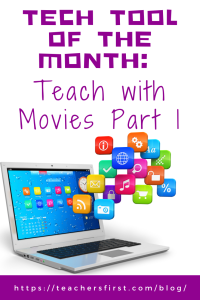Teach with Movies is a fantastic resource that offers free lesson plans and guides to complement movies across various subjects. You don’t need to register; you can immediately access the lesson guides and discussion questions. Every month, we feature specific themes that you can use as a guide to find related movies with accompanying learning guides. For instance, during National Post-Traumatic Stress Disorder Month in June, you can teach about it using relevant movies. Similarly, you can leverage the Americans with Disabilities Act (ADA) and July 4th-related resources in July. You can search for topics by subject or grade level, such as civics, US history, world history, ELA (English/language arts), health, and more.
Moreover, you can explore topics like the Hero’s Journey, Documentaries, and Social-Emotional Health, among others. You can find samples of the guides by clicking on the Discussion Questions and Worksheets tab. Additionally, the site offers many videos that you can stream for free or find through links. The site is compliant with the DMCA (Digital Millennium Copyright Act). Lastly, you can subscribe to their newsletter to stay updated on the newest movies added to the site and monthly themes.
Applying the Triple E Framework
The Triple E Framework, created by Dr. Liz Kolb, believes that “effective technology integration begins with good instructional strategies and not fancy tools” (tripleeframework.com). Dr. Kolb wrote a book on the topic, Learning First, Technology Second (ISTE, 2017), that lays out the three main uses for technology in education: to Engage, Enhance, or Extend learning goals. We can use this framework to decipher why we use specific classroom tools. Here is a rubric based on the Triple E Framework you can use to evaluate whether Teach with Movies (or any other technology) is a good fit with your learning goals and whether you should use it in your lesson.
- Engage in learning goals: Teach with Movies helps students move from passive to active learners by sharing engaging questions about timely movies. Students are motivated to start the learning process by viewing movies that connect to many curricular content areas.
- Enhance learning goals: Teach with Movies creates scaffolding for teachers to use with students while viewing the movies. Teachers have student guides and discussion questions to ask students as they view the video.
- Extend learning goals: Dr. Kolb describes extended learning as an opportunity for students to learn, connect, and collaborate outside the regular school day and bridge the school day and real-life experiences. The videos could be viewed outside of the school day or on a virtual learning day; the videos could be streamed to the entire class simultaneously. The videos could also be used as part of a blended (or flipped) learning lesson.
Please take advantage of Part 2 of the Tech Tool of the Month: Teach with Movies, where we’ll discuss using the tool and classroom ideas. In the meantime, let us know how you have used Teach with Movies in your education setting in the comment section below.


